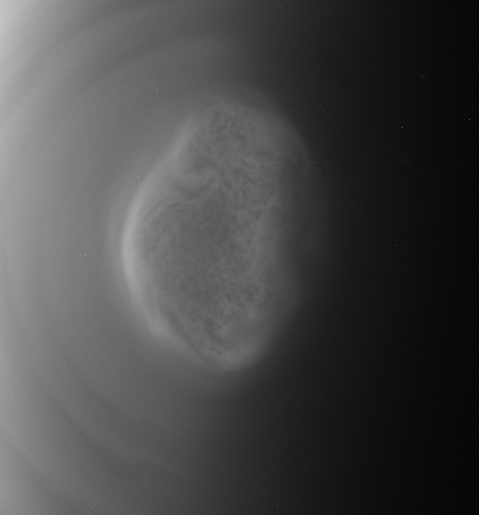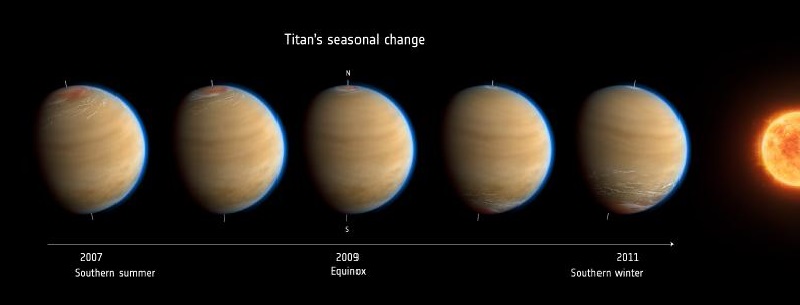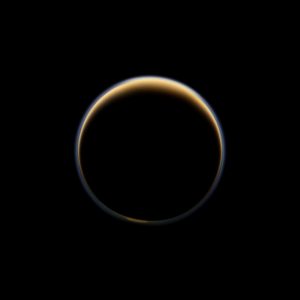11 April 2019
Extended winter polar vortices chill Saturn’s strangely familiar moon, Titan
Posted by llester
By Liza Lester

Titan’s south polar vortex in 2012.
Credit: NASA/JPL-Caltech/Space Science InstituteNASA/JPL-Caltech/Space Science Institute
Saturn’s hazy moon Titan has a long-lived Earth-like winter polar vortex supercharged by the moon’s peculiar chemistry, according to new research published in AGU’s journal Geophysical Research Letters.
Titan is the second largest moon in the solar system and the only moon with a thick atmosphere comparable to Earth’s. The Saturnian moon may be the most Earth-like place in the solar system, with seasons, rain and surface lakes, although it is about 10 times as far from the Sun as Earth and very cold.
Titan’s stratosphere, like Earth’s, is characterized by cooler layers closer to the surface and warmer layers higher up, and is the realm of the polar vortex, a cap of cold air that sits over the poles in winter. This is the same phenomenon that can cause frigid temperatures in North America during the winter.
On Earth, the polar vortex usually dissipates in spring. The new study found that Titan’s northern hemisphere polar vortex sticks around past the moon’s summer solstice, into what would be late June on Earth, lasting three-quarters of a Titan year, or about 22 Earth years.
The new study used measurements from NASA’s Cassini spacecraft and atmospheric science developed on Earth to understand seasonal changes observed on Titan.
The new study expanded previous work by the researchers indicating the presence of the polar vortex on Titan explained the enrichment of trace gases in the moon’s stratosphere and the enrichment of trace gases explained the unexpectedly intense cold observed in the southern hemisphere vortex in early winter.
The combination of cooling caused by trace gases and warming caused by sinking air breaks Titan’s winter into two phases, according to the new study.
“Earth cools in winter due to lack of sunlight over the poles, but you don’t get this added effect from extra gases, whereas on Titan you’ve got these weird gases in there that’s making the process even more extreme than it would be otherwise,” said Nick Teanby, a planetary scientist at the University of Bristol in the United Kingdom, and the lead author of the new study.
Previous work from Teanby and his colleagues described the relationship between the trace gases and the polar vortex, but the new study is the first comprehensive analysis of seasonal variation in the temperature and composition of Titan’s stratosphere, based on infrared mapping data from Cassini’s entire 13-Earth-year tour of Saturn’s system.

A vortex and heightened concentration of trace organic gases sits over Titan’s north pole during northern winter, when the pole is tilted away from the Sun, in this artist’s impression of the moon, inspired by data from NASA’s Cassini mission. As Titan moves past equinox and the north pole tilts toward the Sun, a vortex develops over the south pole. Winter is long on the Saturnian moon, where a year lasts 29.5 Earth years. Credit: ESA
“This is the first time one paper has gone into the whole of the Cassini dataset, covering almost half of the Titan year, and looked at how northern and southern polar vortex evolution might differ,” said Claire Newman, an expert in planetary atmospheres at Aeolis Research and a researcher unaffiliated with the new study. “I work on atmospheric models and we rely on these kinds of observations to understand how correctly our models are capturing what is going on on Titan itself.”
In the future, the authors of the new study hope to have enough data to apply Earth’s atmospheric models to Titan and attempt to predict climate trends on the moon. Testing models on a whole new world could help scientists make the models more robust. One day, Saturn’s unusual moon may help scientists better understand the atmosphere of our home planet, Teanby said.
“Why it’s so interesting is that Titan is like a mini Earth with a really exotic and cold atmosphere that we can use to test climate models and things like that,” Teanby said. “That’s the big picture to why we bothered, but I guess the real motivation is just that it’s really cool to try and figure this stuff out.”
Winter whirl
Titan spins on an axis tilted to about the same degree as Earth’s, which gives the moon seasons like Earth’s, but drawn-out over the 29 Earth years Titan and Saturn take to circle the Sun. NASA’s Cassini spacecraft observed the turning of Titan’s seasons, from mid-winter through summer solstice in the moon’s northern hemisphere.
When Cassini arrived at Saturn in 2004, Titan’s northern pole was enveloped in a polar vortex from the pole to about 45 degrees north latitude, about where the southern border of Montana is on Earth.
A polar vortex is a large cap of cold air and low pressure that sits over the poles in winter, twisting in the direction of the planet’s, or moon’s, spin. Strong westerly jetstreams encircle the pole and contain the cold, creating a distinct separation from warm air from the equator. Jetstream barriers avert mixing of air masses and keep chemicals as well as cold inside the vortex.
On Earth, the edge of this big atmospheric system sits at about 60 degrees latitude, the southern border of Canada’s Yukon and Northwest Territories in the Northern Hemisphere. Lower latitudes encounter the vortex, as North America did last January, when the circling jetstream weakens or meanders.
Cassini found that Titan’s northern polar vortex persisted through the equinox and broke up in summer, much like on Earth, but lasting later in the year. Meanwhile, a new vortex began forming over the southern pole shortly after the moon’s equinox. The embryonic southern vortex was, surprisingly, colder than the northern vortex, which had only been observed in full winter glory.
The new research suggests the difference could be an early winter extra-cold phase produced by Titan’s chemistry rather than intrinsic differences between the poles.
Strange chemistry
The new study suggests Titan’s atmospheric chemistry may accentuate its polar vortex. Like Earth’s atmosphere, Titan’s atmosphere is mostly nitrogen, and the moon’s surface pressure is about 1.5 times Earth’s at sea level. But unlike Earth, the remaining 2 percent of the atmosphere is mostly methane, the main component of natural gas. When it rains on Titan, it rains hydrocarbons.
High in the moon’s relatively hot, upper atmosphere, methane reacts with energy from the Sun and from Saturn’s magnetic field to produce trace gases like cyanide, ethylene, ethane and larger organic molecules. Some of these gases are building blocks of Titan’s characteristic haze.
Cassini observed enrichment of these trace gases over the winter poles and the new research finds this enrichment is most pronounced in early winter, when the pole is also colder.

Daylight scatters through Titan’s atmosphere, seen from the moon’s night side. A hood of haze sits over the north pole at top, and a hint of the south polar votex appears at the bottom in this image captured by Cassini in June 2018, about three Earth years past the moon’s equinox into winter in the southern hemisphere.
Credit: NASA/JPL-Caltech/Space Science Institute NASA/JPL-Caltech/Space Science Institute
On Titan, as on Earth, the difference in temperature between the equator and dark winter pole ultimately drives the formation of the polar vortex. On both worlds, cold air sinks, dragging the upper atmosphere downward at the pole in winter. As the trace gases mix downward into the colder mid-layers of Titan’s atmosphere, they condense to liquid or solid clouds. Condensed trace gases act like a sink, accelerating the movement of more trace gases down from the top of the atmosphere where they are created.
Trace gases make the cold layers of Titan’s stratosphere even colder by emitting infrared light. Infrared light is just beyond the visible light spectrum and is perceptible to humans as heat. When trace gases glow, they lose energy, which has the effect of cooling the atmosphere by radiating energy away into space. The new study proposes the now even colder air sinks faster, in a frigid feedback cycle.
“That’s all happening at the start of winter, so the start of winter is really, really cold,” Teanby said. Eventually, the pressure increase caused by all that sinking air creates its own heat, which counters the feedback cycle. The authors suggest this creates two distinct phases in Titan’s winter.
“As you go deeper into winter and the circulation’s more developed, you get an opposite effect, where you start to warm the stratosphere due to this compression of the air as it’s sinking. So there’s these two phases to winter that are quite strange. We’re not totally sure that’s what’s happening, but that’s our theory at the minute,” Teanby said.
— Liza Lester is a public information specialist and writer at AGU. Follow her on twitter @lizalester.










 GeoSpace is a blog on Earth and space science, managed by AGU’s Public Information staff. The blog features posts by AGU writers and guest contributors on all sorts of relevant science topics, but with a focus on new research and geo and space sciences-related stories that are currently in the news.
GeoSpace is a blog on Earth and space science, managed by AGU’s Public Information staff. The blog features posts by AGU writers and guest contributors on all sorts of relevant science topics, but with a focus on new research and geo and space sciences-related stories that are currently in the news.